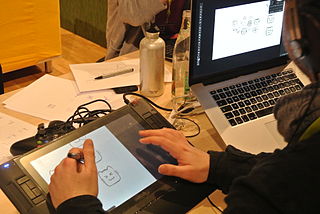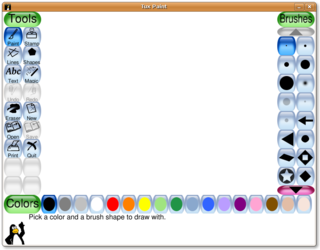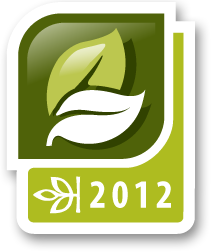
Adobe Photoshop is a raster graphics editor developed and published by Adobe for Windows and macOS. It was originally created in 1987 by Thomas and John Knoll. Since then, the software has become the most used tool for professional digital art, especially in raster graphics editing. Owing to its fame, the program's name has become genericised as a verb although Adobe disapproves of such use.

MacPaint is a raster graphics editor developed by Apple Computer and released with the original Macintosh personal computer on January 24, 1984. It was sold separately for US$195 with its word processing counterpart, MacWrite. MacPaint was notable because it could generate graphics that could be used by other applications. It taught consumers what a graphics-based system could do by using the mouse, the clipboard, and QuickDraw picture language. Pictures could be cut from MacPaint and pasted into MacWrite documents.

Microsoft Paint is a simple raster graphics editor that has been included with all versions of Microsoft Windows. The program opens, modifies and saves image files in Windows bitmap (BMP), JPEG, GIF, PNG, and single-page TIFF formats. The program can be in color mode or two-color black-and-white, but there is no grayscale mode. For its simplicity and wide availability, it rapidly became one of the most used Windows applications, introducing many to painting on a computer for the first time.

Digital painting is an art medium created with computer technologies. It employs pixels which are assigned a color to create imagery. It is also known as raster graphics. It is called digital painting because it initially distinguished itself from vector graphics in its ability to render gradiated or blended colors in imagery which mimicked traditional drawing and painting media.
The Print Shop is a desktop publishing software package originally published in 1984 by Broderbund. It was unique in that it provided libraries of clip art and templates through a simple interface to build signs, posters and banners with household dot-matrix printers. Over the years, the software has been updated to accommodate changing file formats and printer technologies.

A wallpaper or background is a digital image used as a decorative background of a graphical user interface on the screen of a computer, smartphone or other electronic device. On a computer, wallpapers are generally used on the desktop, while on a mobile phone they serve as the background for the home screen. Though most devices include a default background image, modern devices usually allow users to manually change the background image.

Tux Paint is a free and open source raster graphics editor geared towards young children. The project was started in 2002 by Bill Kendrick who continues to maintain and improve it, with help from numerous volunteers. Tux Paint is seen by many as a free software alternative to Kid Pix, a similar proprietary educational software product.
Canvas X is a drawing, imaging, and publishing computer program from Canvas GFX for personal computers.

Family Tree Maker is genealogy software for Windows and Mac that allows the researcher to keep track of information collected during research and to create reports, charts, and books containing that information. The software was originally developed by Kenneth Hess of Banner Blue Software, which was purchased by Broderbund in 1995. It passed through the hands of The Learning Company, SoftKey, Mattel, and others before coming under its current ownership. A redesigned Family Tree Maker 2008 was released on August 14, 2007. The 2009 version of the program corrected some of the errors and omissions of its predecessor, and introduced a few new features. Family Tree Maker 2010 claimed to further enhance the radical redesign and be more powerful and feature-packed with faster navigation and quicker load times.
Jam Session is the 1988 successor to Studio Session, a 1986 software program for Macintosh computers, for music creation and playback. It was created by Macintosh and Newton pioneer Steve Capps and musician Ed Bogas. Jam Session was published by Broderbund Software. Studio Session was published by Bogas Productions.
Amiga software is computer software engineered to run on the Amiga personal computer. Amiga software covers many applications, including productivity, digital art, games, commercial, freeware and hobbyist products. The market was active in the late 1980s and early 1990s but then dwindled. Most Amiga products were originally created directly for the Amiga computer, and were not ported from other platforms.

SuperPaint is a graphics program capable of both bitmap painting and vector drawing. SuperPaint was one of the first programs of its kind, combining the features of MacPaint and MacDraw while adding many new features of its own.

Andy Kulberg was an American musician notable for his bass playing with the groups Blues Project and Seatrain.

Adobe Director was a multimedia application authoring platform created by Macromedia and managed by Adobe Systems until its discontinuation.
This article deals with productivity software created for the Amiga line of computers and covers the AmigaOS operating system and its derivatives AROS and MorphOS. It is a split of the main article, Amiga software.

Mac OS is the series of operating systems developed for the Macintosh family of personal computers by Apple Computer, Inc. from 1984 to 2001, starting with System 1 and ending with Mac OS 9. The Macintosh operating system is credited with having popularized the graphical user interface concept. It was included with every Macintosh that was sold during the era in which it was developed, and many updates to the system software were done in conjunction with the introduction of new Macintosh systems.











